2003.04.25 12:12
Re: liberty architecture moving to ground zero?
4. What do the first Stock Exchange of the USA and the Grosse Neugierde have very much in common?
They both reenact the choragic monument of Lysicrates from ancient Athens.
The Merchant Exchange is designed by William Strickland, 1832, and the Grosse Neugierde is designed by Karl Friedrich Schinkel, 1835-37. Both designs represent an 'international style' of architecture at the time, specifically a style of architecture "learning from" the then recent French documentation of ancient Greek architectures/sites, and hence seen as symbolic of democracy. The Grosse Neugierde now stands at the quondam West Berlin end of the famous Glienicke Bridge where spies were exchanged during the Cold War. The Merchant Exchange, all clad in what looks like and probably is King of Prussia marble, first stood as a beacon for the early commerce of the USA, and today houses the National Park Service's offices of Independence National Historic Park.
5. There are a few other examples were Strickland/Philadelphia architecture coincides with Schinkel/Berlin architecture.
2003.04.26 14:53
Re: liberty architecture moving to ground zero?
A comparative study of the work of Schinkel and his architectural contemporaries in America suggests a surprising early 19th century "international" style based on the newly documented architectures of ancient Greece. The "liberation of Greece" was seen politically by the Europeans as another victory for democracy, and hence the ancient Greek style of architecture became a symbol of democracy, especially in the USA. Schinkel and his contemporaries were thus great reenactors, manifesting a real reenactionary architecturism.
Is an educated blindness to symbolism today's international architectural style?
2004.02.16 11:49
Re: Hedjuk
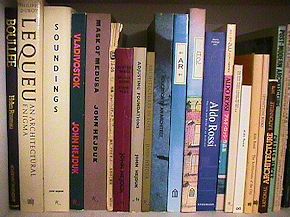
Boullée, Hejduk and Rossi make a very interesting combination. I never seriously thought of them in tandem before, but just now when I looked up at my bookshelf, the Boullée book is right next to the seven Hejduk books, which are right next to the eight Rossi books--who knew? I've seen two Rossi projects and one Hejduk project, all in Berlin. All three architects are now dead.
death of Rossi
death of Hejduk
Boullée was born 12 February 1728 and died 6 February 1799. Boullée never married.
Piranesi had some influence on Boullée, and Boullée had some influence on Gilly and subsequently Schinkel. Of the architects mentioned so far, all were prolific designers, but only Rossi and Schinkel were prolific in the built sense.
2003.10.19 17:25
Re: The Disney, inside
The tiered seating on either side of Wright's Unity Temple is exactly what made me recall Schinkel's many Lutheran church designs (c. 1830-40), where the layouts often have double tiers of seating on either side facing the central seating space, and there is at least one design where there are triple tiers.
It is also interesting to see the seating layout of the Friends Meeting House (on Arch Street, not Race Street, 1803-11), and then compare it to the seating layout of the two chambers in Congress Hall (next to Independence Hall, a couple blocks over from the Meeting House), where the US Senate and House of Representatives first convened, 1790-1800. The Senate chamber is upstairs, and somewhat formal, though also smaller and even intimate, while the House chamber downstairs is large, and has a public feel to it, especially with the doors that go directly outside. There is a distinct similarity between the layout of the Friends Meeting House and the layout of the first House of Representatives.
Although the Friends Meeting House on Race Street was built after 1800, the fact that Philadelphia was founded by William Penn, a Quaker, in 1683 suggests that there where other Quaker Meeting Houses in Philadelphia prior to Philadelphia being the nation's capital.
| |
2005.09.08 13:48
Hadrian was born in Spain
The reality is that we really don't know to what extent Hadrian "designed" any buildings. That Hadrian was Emperor supersedes his "practicing" any other "occupation." A good example would be the relationship between Schinkel and Crown Prince (later King) Friedrich Wilhelm IV where one of the Prince's sketches is almost exactly what Charlottenhof is today. Yes, Schinkel is the architect of Charlottenhof, but Friedrich Wilhelm IV is Charlottenhof's original designer. It's strange though because Friedrich Wilhelm actually "couldn't" be an architect because that was beneath his station. Hardian could well have designed a lot of buildings, but for someone back then to call him an architect may have at the same time amounted to insulting his (higher) station.
Today we call the designer of a building the architect, even though there are many more people (including other architects) involved in the development and production of architecture.
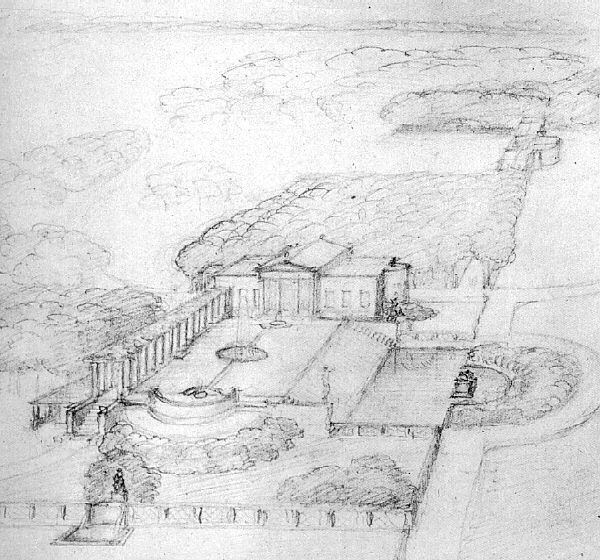
"The Crown Prince [later Friederich Wilhelm IV] counted Schinkel as one of his teachers, at least as far as architecture and drawing were concerned. Schinkel's instruction to the Crown Prince was always based on concrete examples from his practice. The prince accompanied the creation of the Charlottenhof park and palace with an unusually large number of sketches and plans, and esteemed his own part in the planning very highly."
Heinz Schönemann, Karl Friedrich Schinkel: Charlottenhof, Potsdam-Sanssouci, 1997.
2005.09.08 14:09
Hadrian was born in Spain
The Crown Prince sketched lots of architectural designs, and, had he the money, he likely would have had them all built.
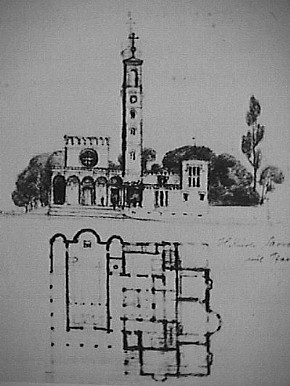
Sketch for a Church at Sakrow

Sketch for a Polytechnikum on Königsplatz
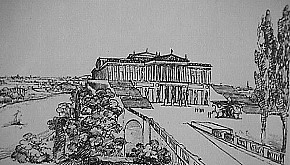
Design of Schloß Belriguardo on the Tornow
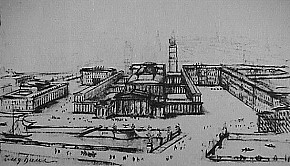
Design of the Berlin Dom
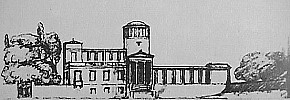
Sketch of Schloß Lindstedt
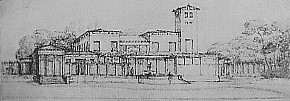
Sketch in connection with the Gardener's Villa in Sanssousi
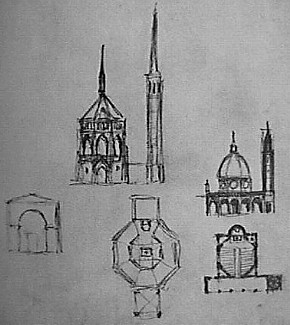
Sketch of central churches
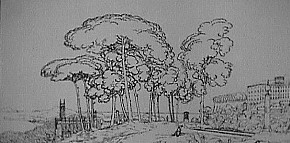
Ideal landscape with church
Ludwig II had tons of money (the Wittelsbach Treasury in Munich is still the most valuable in Europe), and "his" (reenactionary) architectur(ism) did get built. Yes, Ludwig employed several architects, but hardly a design (sketch/drawing) got by without his changes and ultimate approval.
| |
2008.04.27 11:23
the state of drawing in education
I can still remember the first time I went "to do some CAD for fun in my spare time." It was Labor Day, 1983. By this time I had been employed as a CAD architect for just about four months. I mostly did contract documents, but I was also allowed to teach myself 3D modeling for like an hour a day. Outside of work, one of my interests then was the architecture of K.F. Schinkel. At the time it still wasn't clear to me how the staircase behind the columns of the Altes Museum worked, so I went to the office on Labor Day and started a model of the Altes Museum staircase.
Since June 1987 I've had my own CAD system at home, and in the last 21 years I have often done some CAD for fun in my spare time.
As far as the state of drawing in education, the main issue remains dexterity. Of course, if drawing by talking becomes a reality, then the main issue will be the gift of gab.
2008.12.14 10:40
Shape and Form
Louis Sullivan's form follows function argued against architecture's form having become too removed from its function--banks shouldn't look like ancient temples; bankers don't wear togas. When Sullivan was in Philadelphia working at Frank Furness' office, 1872-73, it was on the same block as, if not right across the street from, William Strickland's Second Bank of the United States, with very severe Doric temple fronts, 1819-24. Strickland's Philadelphia architecture was meant to represent the United States as the new democracy, thus emulating (reenacting) the architecture of the old democracy of ancient Greece. Note, however, the similarity of the contemporaneous works of Strickland and Schinkel point to other factors also being present within the formulation of Strickland's style, likely the influence of the "Grand Durand".
4703
2011.01.24 21:18
what is our current architectural style called
Architecture style is no longer defined by space, rather by time.
"Their house is the epitome of 2002 style."
"Design me something early 1840s. I'm feeling immediate-post-Schinkel lately."
"In the year 2525, when architecture is finally alive..."
2013.04.30 16:56
Hitler's Words Into Stone. Can architecture itself be fascist?
Schinkel was a gifted experimenting eclectic and a very talented assimilator. He study-toured Italy, Paris and England; he never visited Greece. His primary clients/employers were Prussian royalty and the Prussian government; there was no German nation yet. Schinkel did on occasion speculate as to what the most fitting style of architecture for Prussia might be, while at the same time many thought Cologne Cathedral to be the best symbol of 'German' architecture. The notion of Schinkel's architecture being a glorification of German culture came after the fact. Leo von Klenze, Schinkel's contemporary in Bavaria, did do a few projects where the program was to glorify German culture, however.
In many ways, Schinkel also learned much from architectural publications of the time, particularly Piranesi, Durand and Stuart & I forget his name's record of ancient Greek architecture.
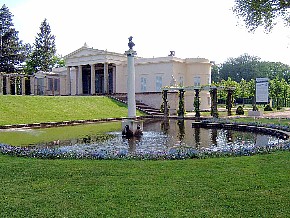
Incidentally, the first scheme for Charlottenhof (above) was drawn by the Crown Prince for whom the villa was built.
| |
2013.07.25 08:16
Traditional/Classical Architecture- Part 2
There's a very interesting relationship between the architecture of Strickland and Schinkel. For example, compare the (space-time) of the Neue Wache and the Second Bank of the United States. Did they know of each other's work? I have no idea, but the space-time similarities are sometimes uncanny. Did they just happen to have access to (and devour) the same books and 'magazines'?
Koolhaas/OMA has been steadily building upon the components of architecture's tradition of the last 100 years or so.
The more traditions stay the more they change the same?
2013.07.30 14:15
30 July
Finished reading Log 28 this morning--been reading it since last Thursday. Also been thinking of starting a thread about it--Stocktaking 2013. In any case, there are many passages worth remembering and even discussing. For example (and off the top of my head), Kipnis saying very similar things vis-à-vis (a comparing of) Gehry and Schinkel; PVA lamenting 'destruction' via tweets, Lynn now working in 'isolation', Diller meeting a non-architect that took Venturi's history class and said it was the best course he ever took; AZP's personal CAD history; what Whiting described as 'evil'; etc. There's also the almost invisible veil of fear that postmodernism may not be dead.
2013.11.04 17:18
Why won't you design what we (the public) want?
Just to interject regarding Schinkel, the wikipedia entry is misleading. The Crown Prince was about seventeen years old when Schinkel began designs for the Altes Museum, and it was about that time that Schinkel began giving lessons to the Crown Prince in drawing and design. Thus, the notion of 'influence' definitely goes both ways. Also, I've seen reproductions of several of the Crown Prince's architectural sketches, and I don't recall seeing one of the Altes Museum, although that doesn't mean one such sketch does not exist. Moreover, for the real influence on the design of the Altes Museum, look to Durand.
...be careful when writing Gropius and Schinkel in the same sentence. Schinkel was a student of architect Martin Gropius, and I think Schinkel even lived within the Martin Gropius household as a student.
2013.11.04 19:29
Why won't you design what we (the public) want?
Was just inspired to write a 'historical' novel where Schinkel uses the 'influence' of the Crown Prince to get to do the designs he, Schinkel, wants. The Crown Prince figures out Schinkel's stratagem and thus starts changing his mind like every week or so as to what style a project should be designed in, just to drive Schinkel a little crazy, but also to see just how clever Schinkel can be. Schinkel, in turn, figures out the Crown Prince's stratagem and hence the architecture just starts getting more and more weird. [Wolfhilde von Schlittenfahrt, the sexy, new intern in Schinkel's office quickly becomes aware of the dueling stratagems and immediately starts 'busting' in her own stratagems.] Add to that that both Schinkel and the Crown Prince are obsessed with the life and works of Heinrick von Kleist and participate in a secret Von Kleist Society where all forms of strangeness ensue. Working title: Kohlhaas wo bist du?
not there 3800c 3800d
2016.01.21 13:58
Scott Merrill wins the 2016 Driehaus Prize
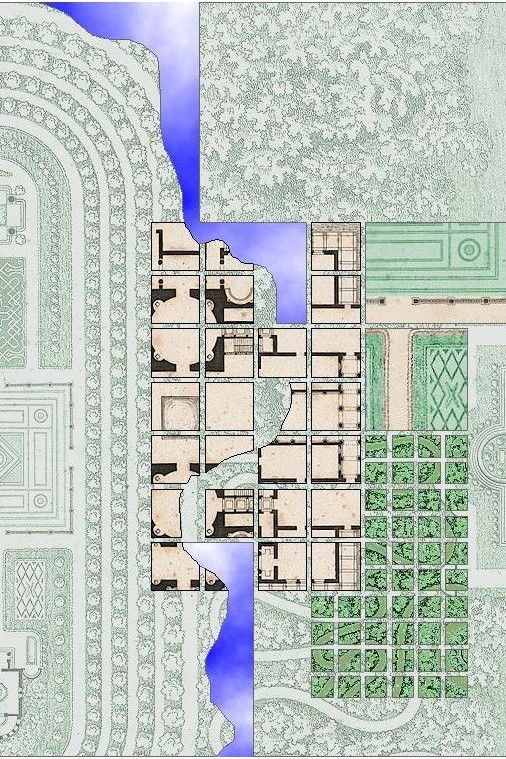
duplication, imitation, mimicry, novelty, classical, modern style
|